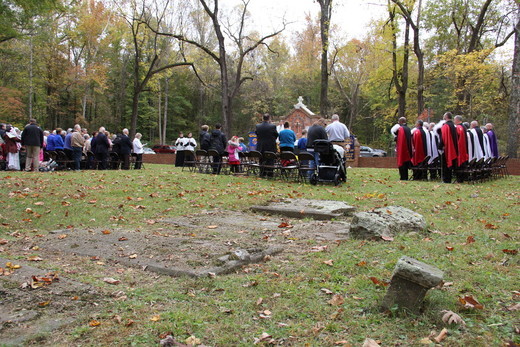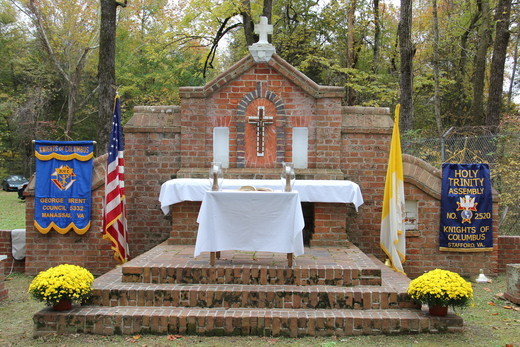This story first appeared in the Arlington Catholic Herald, the award-winning newspaper for the Catholic Diocese of Arlington, Virginia.
A little-known knob in the tree of Virginia history lies at the end of a dirt road in Aquia. Neighboring St. William of York Church in Stafford and flanked by wooded swampland, the Brent Family Cemetery dates back to 1686, when King James II of England granted George Brent a swath of 30,000 acres nestled between the Potomac and Rappahannock Rivers. With that grant, the king also issued a royal mandate for the Brents to freely practice their Catholic faith.
Brent was the nephew of Maryland Governor Giles Brent who, with his better-known sister, Margaret -- a businesswoman and the first American woman to demand the right to vote -- fled to Virginia in 1649 following attacks led by Protestant ship captain Richard Ingle. Like many Catholic families after the outbreak of the English Civil War, they no longer felt safe in Maryland. Thus, the Brents became the first Catholic family to settle permanently in Virginia.
This was the legacy observed at the Brent Family Cemetery Oct. 24, when the Knights of Columbus, the Catholic Woman's Club of Richmond, St. William of York Church and other community members convened for a Field Mass. The faithful worshipped to sunshine and birdsong among the graves, surrounded by trees ablaze with the colors of Virginia autumn.
In his homily, Father Anthony J. Killian, parochial vicar of St. William of York, called upon those present to reflect on what he described as "transtemporal reality," or man's ability to "reach across time."
"Our faith assures us that death is not the end," said Father Killian. "Death does not obstruct our bond with those who died centuries ago."
He also mentioned the Brent family's courage for observing their faith during a challenging time in Catholic history.
"Think of what they had to do," he said. "It's so easy for us now -- now, but we have to prepare for the future."
The Mass featured a patriotic witness of the Knights Honor Guard, a blessing of the wreath commissioned by the Catholic Woman's Club and "America the Beautiful" as the recessional hymn.
The Field Mass tradition dates back to Oct. 6, 1929, which was a few years before the Catholic Woman's Club undertook cemetery preservation efforts. They cleared the land, built the brick wall that now encircles the bulk of the burial ground and erected the altar. In 1930, the Catholic Woman's Club also had a crucifix installed at the intersection of Route 1 and Telegraph Road near the cemetery. The bronze monument -- which was designed by sculptor Georg J. Lober, who apprenticed under Mount Rushmore sculptor, Gutzon Borglum -- commemorates the Brent family and religious tolerance.
Today, the Catholic Woman's Club does not preserve Brent Family Cemetery in isolation. Other patrons include Knights councils from Manassas, Stafford, Aquia, Quantico, Triangle and Gainesville; Flaherty Ladies of the Fourth Degree; Ladies Auxiliary of George Brent; and Margaret Ladies of Widmer Council.
Carrol J. Frederick is chairman and William A. Edmond is co-chairman of the Brent Family Cemetery Committee, which also includes Father Killian, James H. Everett, David S. Hermann, Thomas G. Vetter, Daniel J. Sullivan and James A. Lowder. Among the committee's associate members are representatives from the Stafford County Cemetery Committee and the Arlington Diocese, with Martha Williams serving as the consulting archaeologist.
At a luncheon following this year's Field Mass, Holy Trinity Assembly No. 2520 made a presentation outlining current and planned actions for the Brent Family Cemetery.
A developer who recently purchased land near the cemetery, which qualifies as a Virginia Historical Site, has promised a donation of $10,000 once its first subdivision plan is approved. The developer also has agreed to improve the access road, resurvey the property and help install an on-site power drop. The donation will be made to the Arlington Diocese and then applied according to the committee's plans.
In addition to maintaining the grounds and fighting vandalism, the committee hopes to identify the cemetery's graves. Specifically, the committee wants to pinpoint the burial locations of the aforementioned Margaret Brent and her great-grandniece, Sarah Brent Mason. Mason was the second wife of Founding Father George Mason, who drafted the Virginia Declaration of Rights. David Hermann contacted the National Geographic Society Oct. 3 for assistance in the search, but has yet to receive a response.
These endeavors will preserve the church's legacy in Northern Virginia, while ensuring the site remains a pleasant and safe place for worship.
"I come here every year as a pilgrimage," said Brenda Whitlock Latham, president of the Catholic Woman's Club of Richmond. "This is my Mecca."
Find out more
To learn more about the George Brent Council, contact Jim Reynolds at renolds-tribe@msn.com or 703/386-4326.
Photos by Christine Stoddard for the Arlington Catholic Herald. Read more from the Arlington Catholic Herald at www.catholicherald.com.


